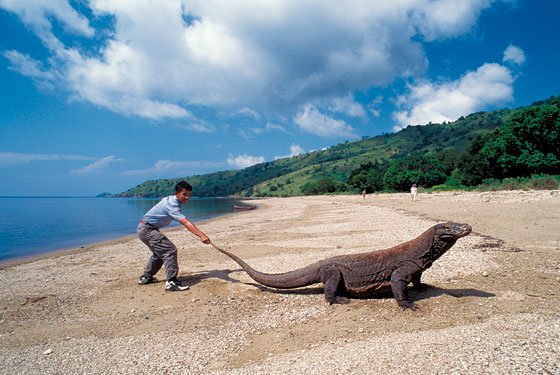
Komodo become a species of dinosaurs that still remain on earth. Although now only found on the island of Komodo, Indonesia, the animal was originally from Australia. This is evidenced by a group of researchers who discovered the fossils of the Komodo dragon 300,000 to 4 million years ago in eastern Australia.
the following interesting facts about these ancient animals:
Eat once a month
Komodo dragons have strong body defenses. The reptile animals were able to hold food in the stomach for a full month.
Swallow prey with weight 80 percent of its body
Although only eat once a month, dragons apparently can spend a very large amount of food. The animal can consume a goat or deer. Komodo's mouth is very elastic. That's what causes him to eat large amounts of food. After a meal, a dragon will sunbathe in the sun to speed up its slow metabolism. Then, when he finished digesting, he would spit out a stomach pellet of hair, horns, teeth, and other food scraps. Furthermore, although predatory, dragons more often eat carcass than hunt. They can even detect carcasses that are 10 kilometers away and often uneart newly buried corpses.
Can swim and climb
Komodo dragons belong to reptiles. Even so, the animal turned out to have other capabilities such as climbing and swimming. Komodo climbs to keep away from larger dragons. While the time has run out of food, the animal will usually swim.
Cannibal
Komodos are included in cannibal creatures. If there are no other animals that can be preyed, the Komodo dragon may target his smaller companion. To avoid predation by his own friends, not infrequently the small dragons climbing into trees or rolling in the feces.
Reproduce without sex
Female dragons are able to reproduce sexually and asexually through the process of parthenogenesis. They have a hormone that has partenigenesis work as a substitute for sperm cells.
Saliva is harmless
More than 10 years ago researchers believe that the saliva of Komodo dragons contains deadly bacteria. But this theory has been broken. In 2009, biochemist Brian Fry put forward his findings. Apparently, dragons have poison glands that are loaded with blood pressure-lowering toxins. Such toxins can cause major bleeding by preventing blood clots causing the victims to be shocked. Instead of using bacteria as a poison, dragons actually use toxins. Based on the careful analysis of the Komodo Skull, Fry thinks that Komodo dragons can kill with tactics of grasping, tearing, and dripping toxins. Komodo bite with toothed teeth and pull back with strong neck muscles. The result is a large gaping wound. Then, toxins rapidly lower blood pressure and make the prey shock.
Following you! +upvote